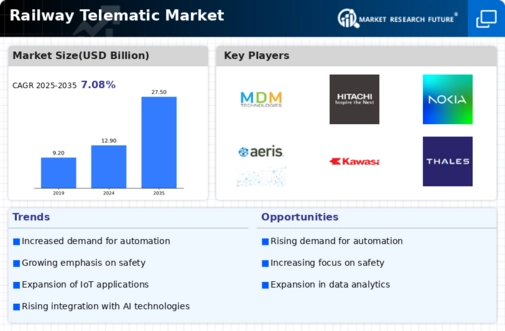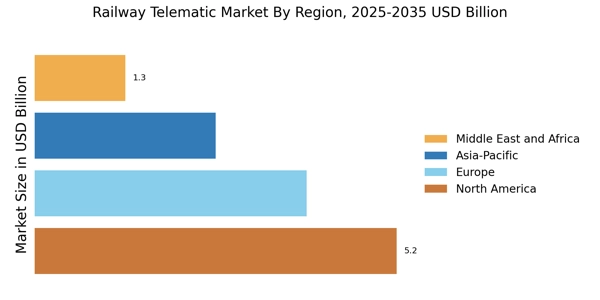Regulatory Compliance and Standards
The Railway Telematic Market is heavily influenced by regulatory compliance and standards set by various authorities. Governments are increasingly mandating the implementation of telematics systems to enhance safety and operational efficiency. For instance, regulations regarding train tracking and monitoring systems are becoming more stringent, compelling operators to invest in advanced telematics solutions. This trend is expected to drive market growth, as compliance with these regulations not only ensures safety but also improves service reliability. The market could see a rise in investments, with projections indicating that compliance-related expenditures may account for a significant portion of the overall telematics budget in the coming years.
Integration of Artificial Intelligence
The integration of artificial intelligence (AI) into the Railway Telematic Market is emerging as a transformative driver. AI technologies are being utilized to analyze vast amounts of data generated by telematics systems, enabling more informed decision-making. This integration can enhance route optimization, improve safety protocols, and streamline operations. As AI continues to evolve, its applications within the telematics sector are likely to expand, potentially leading to more efficient railway systems. The market may experience a notable increase in AI-driven solutions, with forecasts indicating that AI applications could account for a substantial share of the telematics market by the end of the decade.
Growing Demand for Predictive Maintenance
The Railway Telematic Market is witnessing a growing demand for predictive maintenance solutions. As rail operators seek to minimize downtime and reduce operational costs, telematics systems that provide predictive analytics are becoming increasingly valuable. These systems utilize data from various sensors to forecast potential equipment failures, allowing for timely maintenance interventions. The market for predictive maintenance in railways is expected to expand, with estimates suggesting a compound annual growth rate of around 12% over the next few years. This trend indicates a shift towards more proactive maintenance strategies, which could significantly enhance the efficiency and reliability of railway operations.
Advancements in Communication Technologies
The Railway Telematic Market is experiencing a notable shift due to advancements in communication technologies. Enhanced data transmission capabilities, such as 5G networks, are facilitating real-time communication between trains and control centers. This improvement is crucial for operational efficiency and safety, as it allows for immediate updates on train status and track conditions. The integration of these technologies is projected to increase the market's value significantly, with estimates suggesting a growth rate of over 10% annually. As rail operators adopt these innovations, the Railway Telematic Market is likely to witness a surge in demand for sophisticated telematics solutions that can leverage these advancements.
Increased Investment in Infrastructure Development
The Railway Telematic Market is benefiting from increased investment in infrastructure development. Many countries are prioritizing the modernization of their railway networks, which includes the implementation of advanced telematics systems. This investment is driven by the need to enhance operational efficiency, safety, and passenger experience. As governments and private entities allocate funds for infrastructure upgrades, the demand for telematics solutions is expected to rise correspondingly. Market analysts suggest that this trend could lead to a significant uptick in telematics adoption, with infrastructure-related investments potentially reaching billions in the coming years.


















Leave a Comment